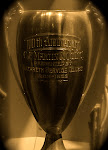
 (The initial 1934 T-fret sample from Horton Angell)
(The initial 1934 T-fret sample from Horton Angell)In 1934, shortly after celebrating their Centennial Anniversary, C.F. Martin made several changes to their line-up. Of the changes, the short lived OM series was discontinued and the “OM” was renamed the “000.” In Martin’s 1934 catalogue, any flattop guitar that featured a 14-fret to body neck joint was named an “Orchestra Model,” while the traditional 12-fret Martin design was named a “Standard Model.” The 000 later that year received the shorter Martin 24.9” scale length (it had been 25.4” since 1902). The bar-style fretwire used the last 100 years was replaced with a modern T-style wire, and along with that, the ebony truss-rod neck reinforcement was replaced with a steel “T”-rod.
Many of us are familiar with these changes, but what might not be too obvious is the actual fretwire material Martin had been using and subsequently used when the T-wire was introduced to the line.
Virtually all fretwire then and now is made of 18% Nickel-Silver, an alloy usually containing approximately 18% nickel, 65% copper and 17% zinc. “Nickel-Silver” is a euphemism denoting a stainless silver substitute, an old term, never actually containing real silver alloy. You’ll find it in the zipper of your favorite old jacket, the silverware your grandmother handed down, your old model railway lines and the musical instruments hidden in your closet. Nickel-Silver became widely used in the 1920s, mainly due to its machinability and corrosion resistance. The higher percentage of nickel used, the harder the material.

 In Clinton F. Smith’s 1927 patent for a “Fret for Musical Instrument," the Attleboro, Massachusetts inventor notes his style ‘T’ wire “preferably disposed in an alternate arrangement, and are not oppositely positioned, although arranged on opposite sides of the fret wire… Each of these frets consists of a wire ‘4’ having lateral projections shaped like the barb of a fish hook as shown. This 'peculiar shape' permits of pushing the frets into place easily but project into the neck of the instrument to securely hold the fret in the place and reduces the possibility of their coming loose when the instrument is in use.”
In Clinton F. Smith’s 1927 patent for a “Fret for Musical Instrument," the Attleboro, Massachusetts inventor notes his style ‘T’ wire “preferably disposed in an alternate arrangement, and are not oppositely positioned, although arranged on opposite sides of the fret wire… Each of these frets consists of a wire ‘4’ having lateral projections shaped like the barb of a fish hook as shown. This 'peculiar shape' permits of pushing the frets into place easily but project into the neck of the instrument to securely hold the fret in the place and reduces the possibility of their coming loose when the instrument is in use.” Although other examples of T-wire were made decades previous, Smith’s “alternate fish-hook arrangement” would prove to be a standard in fretwire design to this day. After receiving sample requests from other fretwire vendors, C.F. Martin decided on the Attleboro based Horton-Angell Company, C. Smith’s employer.
Below is a transcribed portion of a letter from C.F. Martin III to Horton-Angell, dated 8-31-1934:
“Gentlemen: After long consideration we have about decided to change from solid nickel silver frets to T frets and we are interested in your No. 3091 pattern of which you sent us a small quantity last month. We have been using thirty per cent nickel silver wire in the solid frets, rolling it ourselves, and we are very anxious to continue to use this grade of material in the T frets."
Horton-Angell was at first reluctant to produce a T-wire with a higher nickel content for a single account, as it wasn’t a stock option. But upon receiving a request for 100 pounds of the 30% grade from C.F. Martin at a higher cost, they soon agreed.
 It’s unclear in Martin’s records just how long they used the 30% nickel T-wire, and it’s possible it was only produced for this single order. Martin also ordered 100 pounds of 18% nickel wire in this same order, and it’s uncertain in their records as to which guitars received the wire with higher nickel content. It was found however, in Frank Henry Martin’s sales notations during the period, that a young independent luthier from New York was buying bar fretwire from C.F. Martin as early as 1931, presumably because they were manufacturing the unique, resilient wire themselves. John D’Angelico soon became a formative archtop guitar-maker in New York City, along with the fretwire produced at C.F. Martin’s North Street factory.
It’s unclear in Martin’s records just how long they used the 30% nickel T-wire, and it’s possible it was only produced for this single order. Martin also ordered 100 pounds of 18% nickel wire in this same order, and it’s uncertain in their records as to which guitars received the wire with higher nickel content. It was found however, in Frank Henry Martin’s sales notations during the period, that a young independent luthier from New York was buying bar fretwire from C.F. Martin as early as 1931, presumably because they were manufacturing the unique, resilient wire themselves. John D’Angelico soon became a formative archtop guitar-maker in New York City, along with the fretwire produced at C.F. Martin’s North Street factory.

